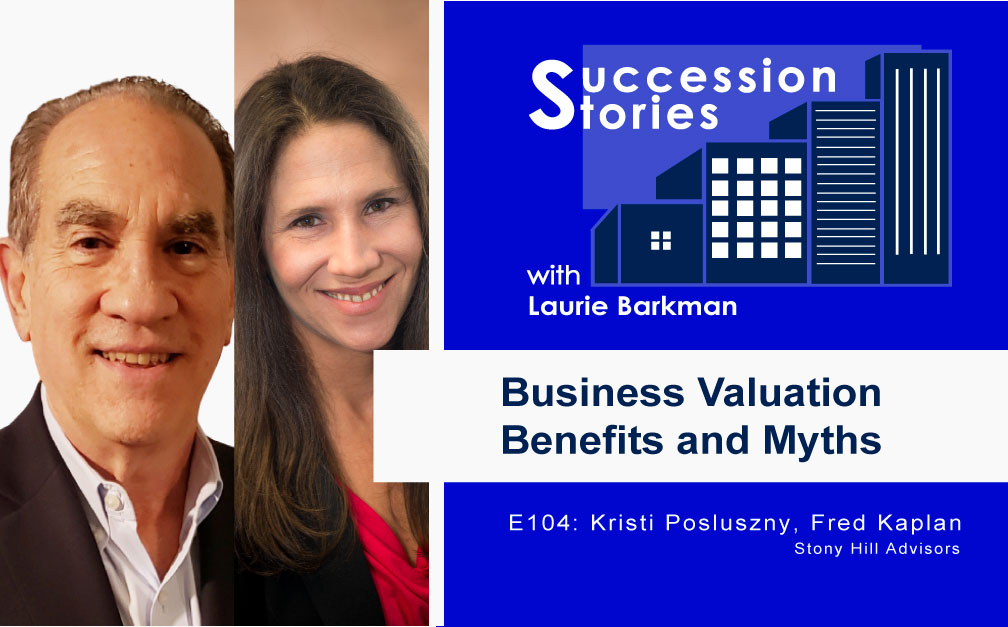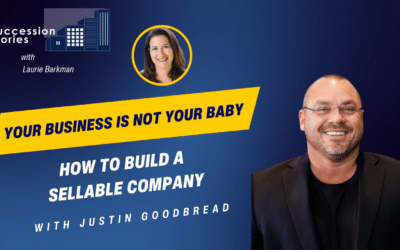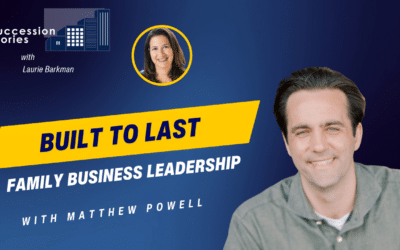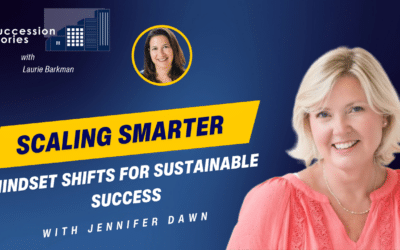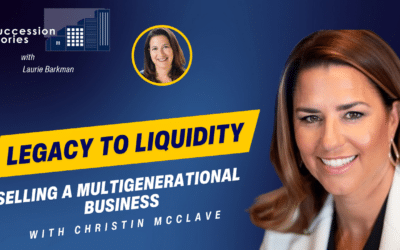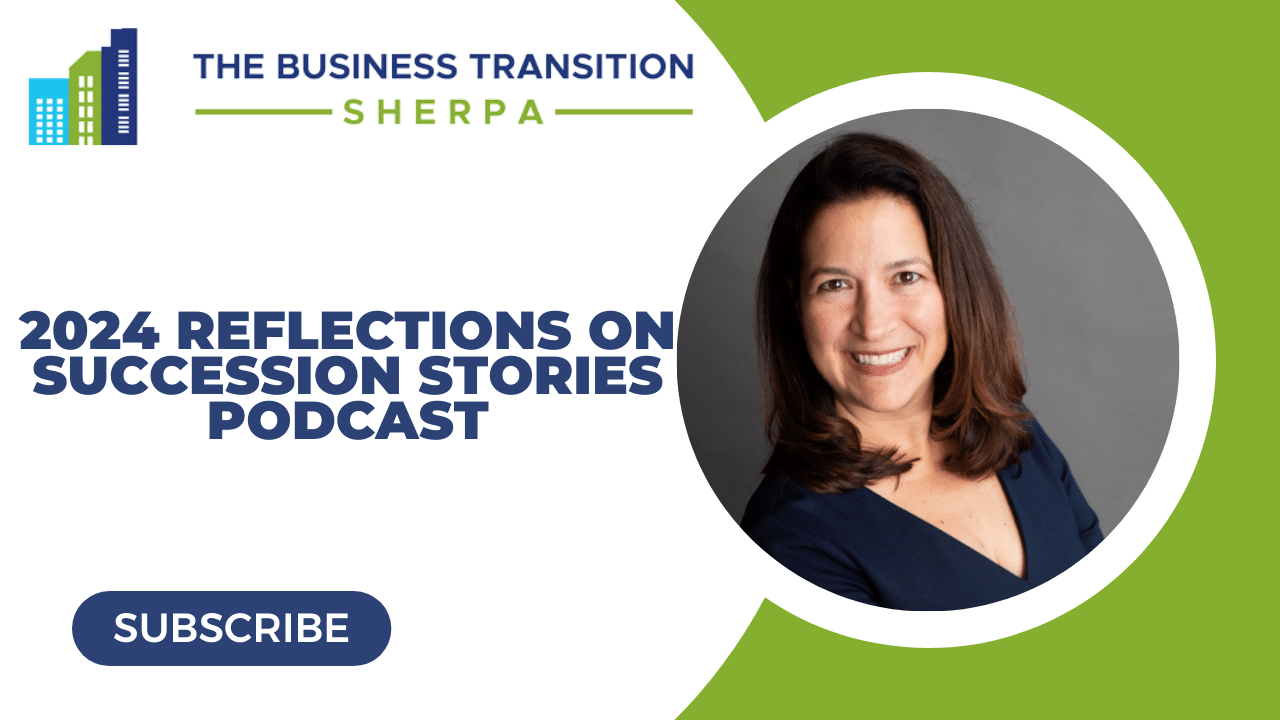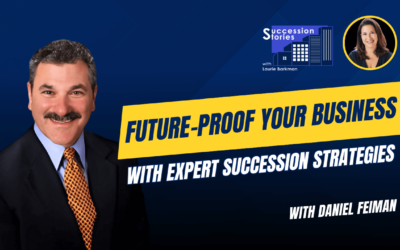98% of business owners don’t know what their business is worth. It’s risky not to know what the value of your business is since it may be the largest piece of your net worth. This can be a problem for owners who are not able to recoup their investment when they want to retire.
Kristi Posluszny and Fred Kaplan from Stony Hill Advisors join host Laurie Barkman to discuss business valuations. Stony Hill is a mergers and acquisitions advisory firm for small to mid-size companies across the US.
Kristi has a background in Investment Banking and Middle Market M&A with a focus on advising companies through a sale process to both strategic and financial acquirers. Fred is a former middle-market CFO and financial consultant, and has advised companies and performed due diligence on M&A and investment transactions in various industries.
Listen in as they discuss common myths around business valuation, valuation methodologies, and why it’s important to measure value.
Show Links
Stony Hill Advisors: www.stonyhilladvisors.com
Kristi Lutes Bio: https://stonyhilladvisors.com/kristi-lutes
Fred Kaplan Bio: https://stonyhilladvisors.com/fred-kaplan
Stony Hill Valuation Webinar on YouTube: https://www.youtube.com/watch?v=OkRo64JIKjs
About Succession Stories Podcast
Succession Stories is an award-winning podcast hosted by Laurie Barkman, the Business Transition Sherpa– guiding business owners through the process from “transition to transaction.” Subscribe to Succession Stories and share a review if you enjoy the show!
Learn more at https://thebusinesstransitionsherpa.com
Book a 1:1 Advisory call at: www.meetlauriebarkman.com
_______________________________________
Become an Official Patron of Succession Stories Podcast:
https://www.patreon.com/lauriebarkman
Don’t leave your exit to chance.
Stony Hill Advisors works with owners like you to get ready and maximize value when you’re ready to sell.
Visit www.stonyhilladvisors.com/podcast for a complimentary business valuation.
Transcript
Intro:
98% of business owners don’t know what their business is worth. It’s risky not to know what the value of your business is since it may be the largest piece of your net worth. This can be a problem for owners who are not able to recoup their investment when they want to retire.
That’s why I invited my colleagues, Kristi Posluszny and Fred Kaplan, to the show to discuss the topic of business valuations. We are Partners with Stony Hill Advisors, a mergers and acquisitions advisory firm for small to mid-size companies with revenues between $1M and $50M. Stony Hill is the lead sponsor of Succession Stories and we truly appreciate their support of the show.
I enjoyed having Kristi and Fred on the show to share their knowledge and experience. Kristi has a background in Investment Banking and Middle Market M&A with a focus on advising companies through a sale process to both strategic and financial acquirers. Fred is a former middle-market CFO and financial consultant, and has advised companies and performed due diligence on M&A and investment transactions in various industries.
Listen in as we discuss common myths around business valuation, valuation methodologies, and why it’s important to measure value. I encourage you to save this episode to your favorites to reference again and again. Enjoy this week’s Succession Stories to understand business valuations with Kristi Posluszny and Fred Kaplan from Stony Hill Advisors.
Laurie Barkman:
Kristi, Fred, it is so fun to have you with me today. You’re my colleagues, and I just wanted to take the opportunity to welcome you to Succession Stories and also thank you because both of you were so helpful. When I joined Stony Hill advisors, each of you took the time to meet with me one on one and it’s just been great to work with you over the last year and a half, so again, welcome to Succession Stories.
Kristi Posluszny:
Thanks, Laurie has it really been a year and a half?
Laurie Barkman:
It really has.
Kristi Posluszny:
Time flies when you’re having fun.
Laurie Barkman:
Absolutely. I want to start with each of you. I’m going to ask you the same question. Why did you get into mergers and acquisitions work? Kristi, I’m going to start with you.
Kristi Posluszny:
Well, I got into mergers and acquisitions work for a number of reasons, primarily, because I’m always interested in learning and what’s great about this industry is you’re consistently learning about, not only new businesses, but you’re consistently learning about new industries. Another reason why I love the industry is because you’re consistently building relationships, not only with business owners, but with people who are interested in buying companies and attorneys and lenders, and so many different complementary resources out there, and probably the number one reason is because of the fulfillment you get in real helping your clients realize their goals.
Laurie Barkman:
Absolutely. Fred, what got you into M&A?
Fred Kaplan:
Well, my career has been as a chief financial officer and a fractional CFO and consultant for many years. Prior to joining stony Hill, I had really morphed into more of a business development role and I found that I missed the delivery of the consulting services working with the client and as an M&A adviser, part of what we do is business development, we build relationships and find new opportunities, but we also get to work on the fulfillment side and deliver those results and as Kristi said, watch one of the companies in a transaction walk away with a sizable amount of funding to move on to their next chapter and so that’s really rewarding.
Laurie Barkman:
It’s also, let’s face it, I think we’re–all of us are probably a little bit deal junkies, right? We kind of like the momentum and the satisfaction of taking something beginning to end. I know I do anyway. Well, let’s talk about it. Oh, go ahead, Fred, go ahead.
Fred Kaplan:
I say often, the process is very much like assembling a puzzle, where you have multiple pieces that include the buyers and the sellers and other related parties. If you’re representing a seller, what are the other buyer pieces that are going to make a good match? It’s a bit of detective work and that’s a lot of fun.
Laurie Barkman:
Yeah. 100%. Well, let’s talk about the ‘why’. Why are we here today? Why are we having this episode focused on valuations? I’m super excited about it. Because it’s really the first one that we’ve done in more than 100 episodes, truly focusing on valuations as a topic. We’ve hit on it in conversation, but we’re here to pull back the curtain a little bit and I wanted to start with the why, why are we talking about this? That’s because 98% of business owners, which is pretty close to 100, most business owners don’t know what their company is worth and this is a problem, but why? Why is this a problem?
I think the biggest thing just to tee up the topic here is that’s because the majority of business owners have a lot of net worth locked up in their company. How do they unlock that? How do they ultimately unlock that value when they’re ready to leave, and if they don’t have an exit strategy, or a way to recoup their investment when they retire, what are they left with? That is essentially why we’re here today. Now to dive into the topic. I’m gonna start with Fred. Let’s talk about valuation from the myths or the misnomers. Maybe people don’t really have a sense, again, not only not what their company is worth, they don’t know, but they don’t really know what a valuation consists of so let’s talk about that. What have you seen in your experience?
Fred Kaplan:
Well, one of the biggest misnomers is that, “There’s a given multiple for my company,” and we hear this all the time. “What’s my company worth? Is it worth three times EBITDA? Five times?” The answer is, there is no single number. Yes, there are rules of thumb that will give you guidance as to what are multiples that are common in your particular industry but those multiples first are not necessarily common in a different industry. Just because your next door neighbor was a manufacturer, sold a business at four times EBITDA that does not mean that your service business is worth four times EBITDA.
The second thing is that when you look at precedent transactions, the history of deals that were completed in your field, and look at the multiples that were received, you get an average of what the market says your kind of business is worth but that begs the question, “Is your business average?” Maybe in every average there are companies with values above it and below it and where do you fit? Likely you fit somewhere on that spectrum that is not the average, so I think the biggest myth is when someone hears that, well, recruiting and staffing companies are selling it for x of EBITDA that really may not be an appropriate fit with your particular business.
Laurie Barkman:
That can happen when you go to the golf club, and you hear someone sold his or her company and they got this multiple of four times. They kind of leave that open ended; four times of what? How do we even unpack that? Four times of what, what does that even mean?
Maybe the audience is wondering what EBITDA means and then why that’s relevant and we’re gonna hold that thought. We’ll come to Kristi here in a moment, she’s going to give us a little bit of insight about the math. The other point you made is interesting, which is about where you fit. Have you seen any examples of that? Fred, where one of your clients, or maybe in your experience at Stony Hill, where someone surprised you, where they either punched above the weight class because of some other aspects of their business, or maybe below where you thought they’d be because of some of these other factors?
Fred Kaplan:
Yes, and typically, these underlying adjustment factors that affect the risk behind the deal, are not publicly known. You don’t know whether there’s a lot of customer concentration, and maybe only two customers, what makes that business risky, and will lower that valuation. Maybe their employees have a high degree of tenure and very low turnover. Well, that would entitle you to a premium above average. These are all factors that come out in the valuation methodologies that we use but you really wouldn’t know those details if you were chatting casually, with someone else.
Laurie Barkman:
Yeah, it’s important to know, I think, where do you stand? How often do you find companies should get a valuation?
Fred Kaplan:
Well, I guess it first starts with what’s the purpose? If the purpose is for selling the business, then you want to get a valuation at that time, but you may also need a valuation to set your key person life insurance between partners in a business, or maybe it’s related to your profit sharing plan. I know one business that was actually at an internal financial team doing a quarterly valuation and I advised them that that was really unnecessarily frequent, that conditions were not changing enough to warrant the time spent on it so they’ve moved to an annual approach, but they use that number for a variety of internal purposes.
Laurie Barkman:
I’m gonna jump over to Kristi because we started talking a little bit about some of the numbers or and definitions and I thought maybe it’s a good time to turn it over to you. Why don’t you share the process? What’s the process of doing a valuation?
Kristi Posluszny:
Yeah, I mean, and just to touch on on some of the things Fred said, you know, it’s important to understand that there is a process to the valuation because a lot of times people will think, oh, just look at my revenue or their net income and just throw a multiple on that, and that’s their value. Other times, business owners will sometimes add premiums to what they think their business is worth, due to their blood, sweat and tears that they put into their business over the years.
However, there is an actual process involved in determining an appropriate valuation for a business, and it does start with the financials. In our process, we will always review the business’s tax returns as well as the internal financial statements of the business and we want to analyze this information to understand the trends within the business, understand the business overall in terms of their operations, and ultimately try to arrive at either an SDE number, which is Seller’s Discretionary Earnings, or an EBITDA figure as you mentioned earlier, which is earnings before interest, taxes, depreciation and amortization.
In addition to EBITDA, we will want to have discussions with management to fully understand again, those trends and some of the operations, because we want to find certain adjustments to those EBITDA numbers. Some of those adjustments will include the owners compensation and any related benefits or perks as we’d like to call them that are embedded within the business that are directly associated with the owner. Furthermore, we want to understand if there’s any extraordinary or non-recurring expenses that may have occurred in the most recent time period, such as a large accounting expense, if the company was possibly audited, or a large legal expense, if there may have been a settlement. These expenses don’t reflect how the business operates in the ordinary course so we really want to get a good understanding from a financial standpoint.
Once we do that, we want to understand the qualitative aspects of the business, as Fred had touched upon, there are a couple of areas within a business that will either increase or decrease the value of a business. Like he said, customer concentration, if they only have two customers versus 1000s of customers, that’s a lot more risk. If they were to lose one of those two customers, then they lose a significant amount of their business so that risk is going to decrease their value. However, if they have a substantial amount of recurring revenue within their business, where it’s predictable revenue, it’s coming every single year, like a gym membership every single year, no matter what that will increase value. There are a number of different qualitative aspects within the business’s operation that we also want to understand to figure the valuation upwards or downwards based on the financial methodologies that we will compute. Once we do all of that analysis, we’ll input all of that into our valuation methodologies that we utilize in terms of what’s appropriate to use for the company and then we would impute an overall valuation for the company for them to use for whatever purpose they need,
Laurie Barkman:
I want to come back to something you said about the owner’s discretion on expenses. It’s quite common in the lower middle market, for a business owner to run personal expenses through the company and a lot of times in these tax returns, we see that tax obligations are minimized and that is a strategy, and and that’s, I think, one of the reasons why when you talked about seller discretionary earnings, we are going through the mechanics of this math. You talked about the isolating and what we call the add backs, what expenses would we take out of the business, what revenues might we not count, and so on and we want to try to get to looking at the numbers where a different business owner might make different decisions.
This example, maybe you’ve seen it, and it’s kind of an extreme example, people kind of shake their heads like, wow, but it’s the toilet paper example. Maybe you’re running your personal home toilet paper through the business so you’re saving 30 cents on the dollar but yet, maybe you’re holding back that value. Let’s just use three times EBITDA as an example of valuation here, maybe you’re holding back the value of $3, you’re saving 30 cents, but how do you help clients work through that?
Kristi Posluszny:
Yeah, I mean, listen, when it comes to the tax returns, and tax liability, accountants are doing their job. I say it all the time, they’re doing their job for you on your behalf to minimize your liability. My job is to undo their job, because what we ultimately want to do is show what the actual business is doing from a financial performance standpoint. Ideally, we would love to have a business owner prepare ahead of time for a suitable valuation by separating their business and personal financial records so that they can show exactly what the business is doing from an expense standpoint. If that’s not going to be the case, we will work with the business owner and management to strip that information out because like you said, while they may be saving 30 cents, it is actually decreasing their value because it’s ultimately decreasing their cash flow and their valuation is essentially based on cash. Like I said, while the accountant is trying to minimize that income figure, I’m trying to maximize as much as I can.
Laurie Barkman:
Have you seen that too, Fred, in your experience?
Fred Kaplan:
I have. Most of the business owners I meet, either focused on minimizing their taxes, so finding as many expenses as they can to offset their income, or they’re focused on maximizing current year profits for the benefits that those provide. What I try to do with them is to introduce a third lens, which is a valument in that if you wanted to buy a business, would you prefer a business that shows no profit? Because that’s one way many owners manage their business. Of course not so sometimes it takes a little time, and this is why in addition to performing valuations, as a moment in time service, we at Stony Hill do exit value planning, where we help companies prepare for a future exit that may not even be imminent, in order to shift that lens from a business that make zero profit and pays zero taxes every year to one that makes money and has what I like to call transferable value to a buyer.
A business can make no profit and still have value to an owner because of the various expenses that are being carried forth and the job that it provides. But as Kristi said, we need to prepare that business to be a suitable investment for somebody else and that means putting on the value lens, what investments might you make now that will have a multiplier effect value in the future? For example, it’s another myth that having no debt is really good for my business. While not having debt has many positive values to it, not making investments in your business will be viewed as a negative in the evaluation process. It means you’re not preparing for the future and you’re not building something, you’re really more treading water and that’s not what a buyer wants to see. A buyer wants to see a business that is moving forward, and that the buyer can take even further.
Kristi Posluszny:
Yeah, and it’s also the same thing, like you’re saying, with debt, with taxes, you may have to pay more in taxes for a few years to make sure your books are relevant but the multiple of the value that you’re going to get supersedes what you’re going to be paying in taxes for those years and that’s what a lot of people don’t understand. They just think, “Well, I don’t want to give the government any more money,” and neither do I, but I’d like to see a little more in my pocket at the end game.
Laurie Barkman:
Well, we’ve given a lot of reasons why the process is important. Maybe let’s talk a little bit about when, and how does this start to happen? In this context, we were saying it’s good to be proactive. Maybe we want to get a baseline of where we are today. Fred you were alluding to this, that maybe we need to, if we have a gap, maybe we have a gap, if we want to retire and exit the business and maybe the business we expect it to be selling for 10 million, but today’s valuation is really showing it at five, wait, how are we going to double? How are we going to double that enterprise value? Kristi, why don’t you share from your experience the process? Where does it start and really, what should an owner do to get a valuation?
Kristi Posluszny:
Well, the first thing you want to do is put aside the owner’s extraordinary expenses. If you’re looking to do a valuation today, just to get a baseline of where you’re at, the first thing you need to do is absolutely make sure that number one, you have all of your business tax returns completed for the most recent calendar year. I know a lot of businesses will go on extension but before we start any valuation, we need to have the most recent calendar year tax returns done. In addition to that, make sure your books and records internally are consistent, prepared well and organized efficiently.
I’ve seen a number of times where business owners aren’t really well versed in the financial aspects of their businesses and will record certain line items in inappropriate places so it’s important to have those records to be organized appropriately because we do analyze both sets of data for the valuation. In addition to that you want to really sort of focus a lot on some of the qualitative factors within the business because those have a significant impact on the valuation and we’d be happy through additional discussions to go over, through our conversations with you in the valuation process, what some of those qualitative factors are, how they are positive to your valuation, and while some of them may be negative as to where you can make improvements upon.
Laurie Barkman:
Fred, from your perspective, what do you think listeners should take action on if they want to get ready?
Fred Kaplan:
In addition to having your books and records current, there needs to be attention paid to planning because when a buyer buys a business, they’re not buying history as much as they’re buying your future cash flows so the seller should have projections of the future cash flows that are reasonable and substantiated, so that the evaluation consultant would be able to use those in our projections of the value of that business. I also see that qualitative factors are very important, as Kristi said, some will bear a discount to the arithmetic part of the valuation, some will generate premiums so it’s very important to understand what are the value drivers of your business and your industry. They’re not necessarily the same for everyone.
Laurie Barkman:
Yeah, absolutely. I think we’re advocating for this proactive valuation to baseline where you are today, understand where you want to be, and see if there’s a gap, but then we probably should just talk about the mergers and acquisitions process as advisors. How do we use the valuation as the beginning point of a, let’s call it a seller engagement, we’re working with a seller to help represent them for a sale, so why don’t we quickly touch on that, because that gives context also to the bigger picture here of how it gets used? Kristi, you want to jump in on that one?
Kristi Posluszny:
Absolutely. One of the primary reasons we do valuations here at Stony Hill is for clients that are looking to potentially sell their businesses and we can get into this a little more, but there are a lot of other reasons why a company would want a valuation to be completed, but for our purposes, the first step is obviously understanding what our client is worth within the market. We want to make sure we set the stage appropriately for not only our client’s expectations, but for the buyer’s expectations as well so we want to place the appropriate purchase price on our company as to where we are in the market today, not only from the buyer’s, but also from an economic standpoint, and just overall market standpoint, because that has a big impact on valuations.
That really does set the stage for the overall process and once we have a purchase price determined for the company, we will start our sell side engagement. I like to think of it as being broken up into two parts, so you have your marketing approach, which, we will go to market, and we have a number of different ways we go to market through either direct outreach or online listings and this is a way we look to find that buyer. There’s always one buyer for every business, and we have to find that buyer.
Once we have that buyer, we enter into the second stage of that process. The second stage is really sort of getting the buyer through their due diligence phase, where they can ask all kinds of questions and request additional information. We work with the buyers on financing if they need to get any financing and we’ll work with the attorneys to help draft and negotiate the different agreements that are necessary for the process. Altogether that is the overall sell side process. Seems simple, but it is relatively complex and it is quite a roller coaster but on average, the timing can be anywhere from nine months to a year so I really want business owners to understand the timing aspect of that process because it can be a lengthy one.
Laurie Barkman:
Yeah, absolutely, and that upfront calibration is so important. Fred, I know you’ve run into this issue quite a bit. Have you had clients where you’ve had to really calibrate on what the market would likely bear for the business?
Fred Kaplan:
Yes, it’s really the first thing that prospects ask, “What do you think my business will sell for?” As I said earlier, I can’t really just ballpark that other than by giving a range which can satisfy them to some degree but maybe not maybe not fully know It. Also on the buy side, we have to work on the valuation of our target companies. On the buy side we are advocating for clients who want to acquire or sourcing companies, for them, valuing those businesses to the point of making an offer and a written letter of intent that we craft for our clients, so we’ve got to be very specific as to how much we’re going to offer, pay closing, how much that may be paid in multiple anniversaries of closing one year later, two years later, for example, what type of employment agreement we will be interested in, so there, I guess, backtrack a little bit. Your business valuation is not necessarily the price that will be paid for your business or the price that you’ll get because the purchase price is going to have other factors in it, such as how much you’re closing, how much is going to be deferred employment agreements. Another factor is, if it’s a minority or minority recapitalization, instead of a complete divestiture, all these issues influence what that purchase price is going to be. It’s important to understand that evaluation is a foundation for getting to that purchase price.
Kristi Posluszny:
Right. In addition, it also depends on the structure of the deal, whether it’s going to be an asset purchase, or a stock purchase, that also has a big variable in terms of what ultimately, the business owner is going to see at the end of the day, and how it’s structured.
Laurie Barkman:
Absolutely. I think probably all our heads are spinning right now. We’ve given a lot of information and I know maybe there was a follow up here. Maybe we have you guys come on again and we’ll talk again about valuations and other topics in the future, so I really appreciate you coming on today, and if people want to follow up with you, for our listeners who want to learn more, what’s a great way to get in touch Kristi, how do they find you?
Kristi Posluszny:
Well, if they want to learn more about Stony Hill advisors, they can visit our website it’s www.stonyhilladvisors.com, and it’s stony—S-T-O-N-Y—a lot of people like to throw an E in there but you can also reach myself at kristi@stonyhilladvisors.com and it’s K-R-I-S-T-Y..
Laurie Barkman:
Fred, what’s a good way to get in touch with you?
Fred Kaplan:
Email’s great. That’s just fred@stonyhilladvisors.com.
Laurie Barkman:
We’ll put all the links in the show notes too. I also want to mention for the audience, if you want to learn more about valuations and our valuation process, Kristi and Fred did a wonderful webinar, and I’ll include the link to that in the show notes also.
As we talk about the rounding down here, and kind of winding up this conversation, I love to ask everyone of my guests for their favorite quote, so you are no exception. Each of you, let’s say who wants to go first, Fred, what’s your favorite quote?
Fred Kaplan:
This is one that I’ve held onto since high school, and it is from a philosopher by the name of George. He said, ‘He who does not remember the past is condemned to repeat it.’ I’ve carried that with me so I make sure I do my research.
Laurie Barkman:
Absolutely, and Kristi, how about for you?
Kristi Posluszny and Fred Kaplan:
Well, my favorite quote is sort of my own mantra, and it’s something I’ve used as I’ve developed my own career and it’s, ‘If opportunity doesn’t knock, build a door.’
Laurie Barkman:
I love that. Build a door. Kristi, Fred, thank you so much. I know we could have talked for another hour, we’re just hitting the tip of the iceberg. You’re both experts in what you do. You’re great to work with and I want to thank you again for coming on to the show.
Kristi Posluszny:
Thank you so much for having us
Fred Kaplan:
My pleasure. This was great fun.
Laurie Barkman:
To our listeners. Thank you so much for your support. You can always catch Succession Stories on any of your favorite podcast players or of course on YouTube. Don’t forget to like and subscribe to the show that really means a lot to us. If you want to maximize the value of your business and plan for future transition, reach out to me for a complimentary assessment at meetlauriebarkman.com. Join me next time for more insights from transition to transaction. Until then, here’s to your success.

